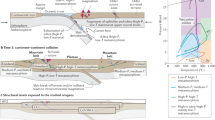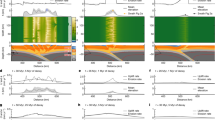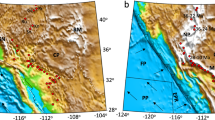Abstract
The structure of a mountain belt reflects the manner in which plate convergence is accommodated in Earth’s lithosphere. However, the extent to which orogenic structure is preconditioned by the thermo-mechanical conditions of the converging plates is debated1,2,3,4,5,6,7,8,9. Here we re-process and analyse existing data on the amount and style of contractional deformation in 30 orogens worldwide and compare this with the lithospheric strength and age of the colliding plates. We find a correlation between orogenic deformation, and specifically the depth at which the crust decouples from the underlying plate, and the age of the lithospheric plate at the time of collision. Orogens formed from Phanerozoic lithosphere, which has high geothermal gradients and weak mantle, are characterized by several under-thrust faults that form in the mid-to-lower crust and moderate amounts of deformation, at less than 35% crustal strain. In contrast, orogens formed on older lithospheric plates, which have greater strength and higher-viscosity mantle, are characterized by a large detachment fault and large amounts of deformation, at about 70% crustal strain. We conclude that inherited lithospheric strength influences the style and amount of plate-tectonic contraction during mountain building, and thus the stability of continental subduction. Our results emphasize the influence of the deep Earth on the structural style of collisional orogens.
This is a preview of subscription content, access via your institution
Access options
Subscribe to this journal
Receive 12 print issues and online access
$259.00 per year
only $21.58 per issue
Buy this article
- Purchase on Springer Link
- Instant access to full article PDF
Prices may be subject to local taxes which are calculated during checkout



Similar content being viewed by others
References
Sykes, L. R. Intraplate seismicity, reactivation of preexisting zones of weakness, alkaline magmatism, and other tectonism postdating continental fragmentation. Rev. Geophys. 16, 621–688 (1978).
Audet, P. & Bürgmann, R. Dominant role of tectonic inheritance in supercontinent cycles. Nature Geosci. 4, 184–187 (2011).
Wilson, J. T. Did the Atlantic close and then re-open? Nature 211, 676–681 (1966).
Babeyko, A. Y. & Sobolev, S. V. Quantifying different modes of the late Cenozoic shortening in the central Andes. Geology 33, 621–624 (2005).
Watts, A. B., Lamb, S. H., Fairhead, J. D. & Dewey, J. F. Lithospheric flexure and bending of the Central Andes. Earth Planet. Sci. Lett. 134, 9–21 (1995).
Cloos, M. Lithospheric buoyancy and collisional orogenesis—subduction of oceanic plateaus, continental margins, island arcs, spreading ridges, and seamounts. Geol. Soc. Am. Bull. 105, 715–737 (1993).
Capitanio, F. A., Morra, G., Goes, S., Weinberg, R. F. & Moresi, L. India–Asia convergence driven by the subduction of the Greater Indian continent. Nature Geosci. 3, 136–139 (2010).
DeCelles, P. G., Ducea, M. N., Kapp, P. & Zandt, G. Cyclicity in Cordilleran orogenic systems. Nature Geosci. 2, 251–257 (2009).
Lowry, A. R. & Perez-Gussinyé, M. The role of crustal quartz in controlling Cordilleran deformation. Nature 471, 353–357 (2011).
Poudjom Djomani, Y. H., Fairhead, J. D. & Griffin, W. L. The flexural rigidity of Fennoscandia: reflection of the tectonothermal age of the lithospheric mantle. Earth Planet. Sci. Lett. 174, 139–154 (1999).
Pérez-Gussinyé, M. & Watts, A. B. The long-term strength of Europe and its implications for plate-forming processes. Nature 436, 381–384 (2005).
Burov, E. B. & Diament, M. The effective elastic thickness (Te) of continental lithosphere: What does it really mean? J. Geophys. Res. 100, 3905–3927 (1995).
Poudjom Djomani, Y. H. P., O’Reilly, S. Y., Griffin, W. L. & Morgan, P. The density structure of subcontinental lithosphere through time. Earth Planet. Sci. Lett. 184, 605–621 (2001).
Jammes, S. & Huismans, R. S. Structural styles of mountain building: Controls of lithospheric rheologic stratification and extensional inheritance. J. Geophys. Res. 117, B10403 (2012).
Watts, A. B. in Crust and Lithosphere Dynamics Vol. 6 (ed. Watts, A. B.) 1–48 (Elsevier, 2007).
Schulte-Pelkum, V. et al. Imaging the Indian subcontinent beneath the Himalaya. Nature 435, 1222–1225 (2005).
Schmid, S. M. & Kissling, E. The arc of the western Alps in the light of geophysical data on deep crustal structure. Tectonics 19, 62–85 (2000).
Artemieva, I. M. The continental lithosphere: Reconciling thermal, seismic, and petrologic data. Lithos 109, 23–46 (2009).
Watts, A. B. & Burov, E. B. Lithospheric strength and its relationship to the elastic and seismogenic layer thickness. Earth Planet. Sci. Lett. 213, 113–131 (2003).
Burov, E., Francois, T., Yamato, P. & Wolf, S. Mechanisms of continental subduction and exhumation of HP and UHP rocks. Gondwana Res.http://dx.doi.org/10.1016/j.gr.2012.09.010 (2013).
Artemieva, I. M. & Mooney, W. D. Thermal thickness and evolution of Precambrian lithosphere: A global study. J. Geophys. Res. 106, 16387–16414 (2001).
Lavier, L. L. & Manatschal, G. A mechanism to thin the continental lithosphere at magma-poor margins. Nature 440, 324–328 (2006).
Le Roux, V. et al. The Lherz spinel lherzolite: Refertilized rather than pristine mantle. Earth Planet. Sci. Lett. 259, 599–612 (2007).
Kidder, S., Avouac, J-P. & Chan, Y-C. Constraints from rocks in the Taiwan orogen on crustal stress levels and rheology. J. Geophys. Res. 117, B09408 (2012).
Hyndman, R. D., Currie, C. A., Mazzotti, S. & Frederiksen, A. Temperature control of continental lithosphere elastic thickness, T e vs V s. Earth Planet. Sci. Lett. 277, 539–548 (2009).
McQuarrie, N., Stock, J. M., Verdel, C. & Wernicke, B. P. Cenozoic evolution of Neotethys and implications for the causes of plate motions. Geophys. Res. Lett. 30, 2036 (2003).
Burgmann, R. & Dresen, G. Rheology of the lower crust and upper mantle: Evidence from rock mechanics, geodesy, and field observations. Annu. Rev. Earth Planet. Sci. 36, 531–567 (2008).
Acknowledgements
We thank T. Gerya (ETH) for his constructive and insightful comments.
Author information
Authors and Affiliations
Contributions
F.M. designed the study and compiled global shortening data. A.B.W. provided updated global Te data and E.B. provided compilation of results from thermomechanical modelling. All authors discussed problems and methods, interpreted the data and wrote the paper.
Corresponding author
Ethics declarations
Competing interests
The authors declare no competing financial interests.
Supplementary information
Supplementary Information
Supplementary Information (PDF 3214 kb)
Rights and permissions
About this article
Cite this article
Mouthereau, F., Watts, A. & Burov, E. Structure of orogenic belts controlled by lithosphere age. Nature Geosci 6, 785–789 (2013). https://doi.org/10.1038/ngeo1902
Received:
Accepted:
Published:
Issue Date:
DOI: https://doi.org/10.1038/ngeo1902
This article is cited by
-
Effect of thermal maturation and organic matter content on oil shale fracturing
International Journal of Coal Science & Technology (2024)
-
Structural and thermal evolution of the eastern Aar Massif: insights from structural field work and Raman thermometry
Swiss Journal of Geosciences (2021)
-
Increased biomass and carbon burial 2 billion years ago triggered mountain building
Communications Earth & Environment (2021)
-
The influence of variations in crustal composition and lithospheric strength on the evolution of deformation processes in the southern Central Andes: insights from geodynamic models
International Journal of Earth Sciences (2021)
-
The transition from thick-skinned to thin-skinned tectonics in the Basque-Cantabrian Pyrenees: the Burgalesa Platform and surroundings
International Journal of Earth Sciences (2015)



